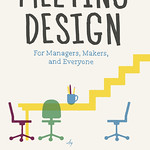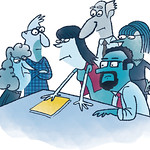Meeting Design

For Managers, Makers, and Everyone
Meetings don’t have to be painfully inefficient snoozefests—if you design them. Meeting Design will teach you the design principles and innovative approaches you’ll need to transform meetings from boring to creative, from wasteful to productive. Meetings can and should be indispensable to your organization; Kevin Hoffman will show you how to design them for success.
Meetings don’t have to be painfully inefficient snoozefests—if you design them. Meeting Design will teach you the design principles and innovative approaches you’ll need to transform meetings from boring to creative, from wasteful to productive. Meetings can and should be indispensable to your organization; Kevin Hoffman will show you how to design them for success.
Testimonials
Kevin Hoffman is the master of meeting design facilitation. After reading his book, I realized my meetings were working against me—turns out just knowing ‘when and who’ isn’t enough of a plan. With Kevin’s guidance, meetings have become more productive and, frankly, more exciting. So before you send your next meeting invitation, read this book.
Kristina Halvorson, CEO, Brain Traffic and coauthor, Content Strategy for the Web
There are a million different ways to think about the design of meetings in the workplace. But as a design professor, I’m using Kevin Hoffman’s book to design better classroom experiences.
Molly Wright Steenson, Associate Professor, School of Design, Carnegie Mellon University
‘Hey, gang! Let’s have more meetings!’ said no designer ever. Derided as a pointless waste of time (because too often, they are just that), meetings have become to the design process what spinach is to Happy Meals. But in viewing and running our meetings this way, we miss a grand opportunity to connect with our end users and create designs that work. In this essential new book, Kevin Hoffman guides us to approach meetings the same way we approach all our design problems—as problems to be researched, planned for, tested, and solved. In Kevin Hoffman’s hands, business meetings become a powerful tool of design. Read his book, and they will work for you, too.
Jeffrey Zeldman, Founder, studio.zeldman and A List Apart
At last, a book that acknowledges meetings as a DESIGN PROBLEM. Read this. Learn it. Put it into practice. Then thank the author when your group work soars.
Sunni Brown, best-selling author and Chief Human Potentialist
It wasn’t until I met Kevin that I realized meetings didn’t have to be painful—in fact, they could be well-designed. In this invaluable book, Kevin lays out a clear, accessible roadmap for his readers, allowing them to make their meetings—and the people in them—work better.
Ethan Marcotte, designer, ethanmarcotte.com
Most meetings suck. They suck time, energy, and enthusiasm out of the room. However, it doesn’t have to be this way. Kevin teaches us a range of simple techniques for turning meetings from productivity sinks into productivity accelerators. Want to leave your next meeting feeling supercharged and ready to go? Then this book is for you.
Andy Budd, owner and director of Clearleft
In any company, meetings are the hub of business thinking and action, and yet we tend to spend very little time thinking about their structure. Meeting Design is a fun, clear, and thorough guide to designing better meetings, to make them more productive, engaging, and effective. This is a fantastic book for anyone who wants to get more out of meetings.
Dave Gray, XPLANE.com
Table of Contents
Foreword by Jeff Gothelf
Chapter 1: How to Design a Meeting
Chapter 2: The Design Constraint of All Meetings
Chapter 3: Build Agendas Out of Ideas, People, and Time
Chapter 4: Manage Conflict with Facilitation
Chapter 5: Facilitation Strategy and Style
Chapter 6: Better Meetings Lead to Better Organizations
Chapter 7: Get Started with Beginning Meetings
Chapter 8: Chart the Course Using Middle Meetings
Chapter 9: Find Closure with End Meetings













